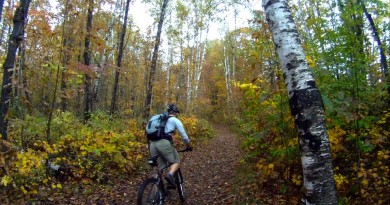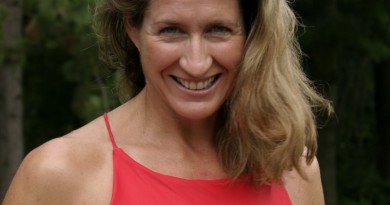6 Steps towards your first open-water swim from Vermont swimmers
For most, the thought of swimming miles in some of Vermont’s largest lakes is a daunting challenge, but the fact is all levels can enjoy open water with the right planning, preparation and support. To help you get your feet wet, Vermont Sports sought the advice from several world-class swimmers and coaches, each with words of wisdom and encouragement.
John Spinney, of Waterbury, is a coach for QT2 Systems, where he trains triathletes. Spinney has completed over 200 triathlons, starting when he was 14. In his earliest races, he says the opening swim was the toughest obstacle.
“For most triathletes and long distance swimmers, that opening swim is the most anxiety-provoking,” he says, due to the intensity and somewhat chaotic atmosphere of the starting line. This summer, he also helps direct weekly swims at the Waterbury Reservoir, open to all swimmers.
Charlotte Brynn, from Stowe, is the Executive Director of the Swimming Hole in Stowe and a veteran of open water swimming. Her resume includes double-crossings of Lake Champlain (16 miles total) in 2011 and 2012; a 25.2-mile swim of Lake Memphremagog from Vermont to Canada in 2012 and a 28.2-mile swim around Manhattan Island. In 2013, she swam across the Catalina Channel in California and completed 19 of the 20.1 miles; swimming 11 hours after a shark left a tooth in her hip. She was a nominee for the Open Water Swimming Woman of the Year in 2013. What’s on her mind while she’s in the water? “How much fun I’m having,” she says.
Bethany Bosch, from Wallingford, swam on a recreation department swim team but didn’t swim her first long distance event until 2010, when she swam eight miles. “I came into swimming backwards,” she says. Since then, she’s has participated in the 25-mile In Search of Memphre swim in the Northeast Kingdom every year and is currently training for her first attempt to swim the English Channel later this year.
Step 1. Find water and people
For a landlocked state, Vermont has plenty of resources for a long swim. Areas to swim include Vermont States Parks and miles of shoreline in Vermont’s pristine lakes and reservoirs. Find a place where you can swim close to shore and even touch the bottom if you need.
In the colder months, a local swimming pool will be useful for maintaining your form as well as for higher intensity workouts. Swimming with others can make the experience more enjoyable and can even push you to train a little harder. Masters classes are available at gyms around the state and offer coaches and swim meets.
“You want to be swimming with people that can push you,” Spinney says. “Swimming with people that are a little bit faster than you can be a huge motivator.”
Step 2. Build up a base
Out on the water, the varying temperatures and water conditions (choppy versus calm) will be more taxing.
“It’s tougher swimming when you add in the elements,” says Charlotte Brynn. “The cold saps your energy stores and you’ll fatigue a lot faster.”
So before you head to the lake, it’s important to gain confidence and strength in the water, which can be done by having a solid base level of fitness. Brynn recommends finding a pace that you can hold for 100 to 200 meters before practicing treading water.
Training out of the water can also help build that level of fitness. Brynn says yoga can strengthen the core and increase flexibility.
Step 3. Get a feel for the water and stay consistent.
When you’ve found a pace and a schedule that works for you, Spinney advises keeping a consistent schedule of your swim workouts.
“In any endurance sport, consistency is one of the biggest factors in terms of improvement,” he says. Swimming technique is something that can be lost if not exercised regularly. If you skip a few weeks, your technique won’t return like riding a bike, Spinney says.
“In biking, you have contact points with the seat, the pedals and the handlebars to help with your technique,” he says. “In running, you have your contact with the ground. But swimming doesn’t have any
contact points, so that makes it more technical.”
A highly technical sport means you’ll need to practice your technique often, so by keeping up on training, you can expect better results.
Step 4. Consider a wetsuit. Like a well-fitting pair of running shoes, the wetsuit is a piece of equipment that can increase your efficiency. The wetsuit will improve your posture and in colder water will help insulate you. Suits designed for triathlons and open water are thinner at the shoulders and thicker at the legs to make the body more buoyant. When you’re putting it on when dry, it should feel small – almost too small. When wet, the suit will expand slightly. A suit that is too big will expand too much and fill with water, increasing drag.
Step 5. Plan ahead and go with support
When Brynn swims somewhere new, she asks local guides, coaches and other people familiar with the body of water about the conditions. When she swims in the ocean, local experts tell her about tides and currents. In fresh water, she asks about the surface of the lake bottom and the conditions on the shore. When out on the water, swim in groups and with a kayak or boat for support.
Step 6. Relax
“People always swim better when they’re relaxed,” says Spinney. If the idea of a longer distance is too daunting, start small and then add distance gradually to build your confidence. The more out in the open water you are, the more relaxed your subconscious brain becomes, he says, adding that stress drains your energy stores more quickly. To prevent this, Brynn pays attention to areas of her body that are feeling the best, thinking positive thoughts and thinking beyond the next stroke.
Bosch says when she’s practicing on the Chittenden reservoir, she often finds herself breaking down distances into numbers of pool laps.
“If I’m going toward the island and it’s 200 meters away, I know that it’s eight laps,” she says. “That way, I know I can make it.”
Bosch says she also plays mental games with herself to quiet her thoughts. She sings and if she starts to feel nervous, she’ll count to herself. It took Bosch 17 hours to complete her first Kingdom Swim, a challenge she said that was as mental as it was physical.
“You’re so alone in your own head,” she says. “You don’t have much interaction with anyone and you really have to keep yourself going.
Relaxation, combined with good swimming technique, helps get you through the distances you set as your personal goals.




